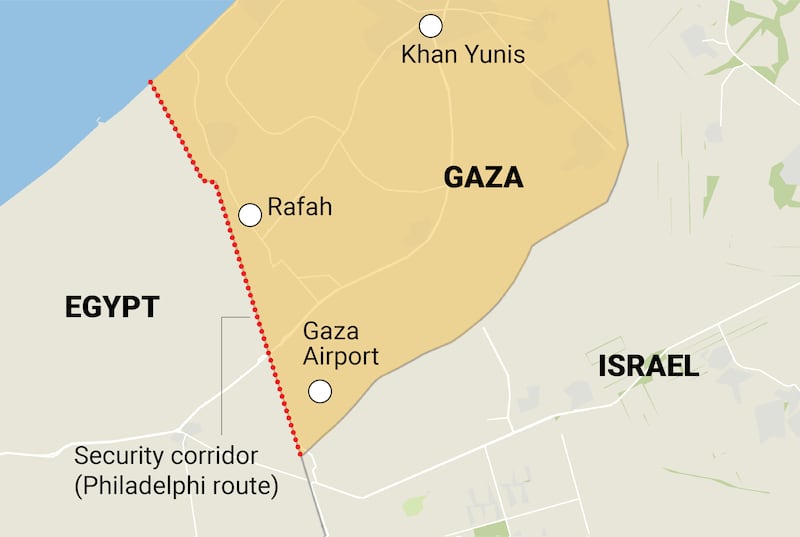With efforts stalled to achieve a new ceasefire, Israel launched an air strike on Rafah on Friday. A decision by its military to advance into the city at the southern tip of the Gaza Strip appears to be just a matter of time.
Before the surprise October 7th Hamas attack, Rafah, Gaza’s third largest city, had a population of almost 250,000. Today, more than half of Gaza’s population is crammed into the area along the Egyptian border, after being encouraged by Israel to flee south to avoid the fighting.
The estimated 1.3 million residents in Rafah, most in makeshift tent encampments, are already suffering a humanitarian crisis with a daily struggle to obtain adequate shelter, food and water. An Israeli military onslaught could be catastrophic.
Israeli prime minister Binyamin Netanyahu, in comments on Wednesday night, indicated that civilians will be allowed to evacuate.
READ MORE
“Our heroic troops are now fighting in Khan Younis, Hamas’s main stronghold. We’ve instructed the IDF [Israel Defence Forces] to prepare also to operate in Rafah and in two camps in the centre, the last strongholds Hamas has left. Here too, when the time comes, the IDF will act in compliance with international law and will allow the population safe passage out of the war zones.”
With much of Gaza already a wasteland after four months of intensive fighting, options are limited for the relocation of another million refugees to (relatively) safe areas. The al Muwasi area along the Mediterranean coast is one option but humanitarian organisations there are already struggling to cope with hundreds of thousands of refugees from the fighting in Khan Younis and elsewhere.
Another option being considered by Israel is to allow the evacuees in Rafah to return to their homes in the northern Gaza Strip, with emphasis on the women and children. No final decision has been made and many of the homes in northern Gaza are no longer inhabitable.
Egypt’s biggest fear is that an Israeli attack on Rafah will force hundreds of thousands of refugees to flee across the border into the Egyptian Sinai — a scenario that has been publicly encouraged by some members of Netanyahu’s right-wing coalition.
In October, Egypt made it clear that it would not allow any refugees from the war to cross into its territory.

The border road between southern Gaza and Egypt (named the Philadelphi corridor randomly by an Israeli army computer) runs 14km from the Mediterranean Sea to Israel’s Kerem Shalom border crossing. The corridor is only 100m wide but is seen by Israel as key to the future of Gaza.
Israel believes that the bulk of the weapons used by Hamas and other militant groups in Gaza were smuggled from Egypt via the Philadelphi corridor, either over ground or via tunnels, and that about a dozen tunnels are still in operation.
“The Philadelphi corridor must remain in our hands and it must remain closed. It is clear that any other arrangement will not be able to guarantee the demilitarisation that we desire,” warned Netanyahu.
Israel controlled the corridor for 23 years after returning occupied Sinai to Egypt under the terms of the 1979 peace agreement between the two countries.
The smuggling tunnels developed into a massive source of income for Bedouin people on both sides of the border (with Egyptian officials reportedly accepting bribes to turn a blind eye) after Gaza came under Palestinian control following the Israeli withdrawal in 2005. The phenomenon grew dramatically after Hamas seized power in Gaza in 2007, with some tunnels wide enough for vehicles to pass through.
Israel’s former defence minister Avigdor Lieberman likened the situation to an open tap. “Somebody with a mop is constantly running around from one corner to the other trying in vain to dry the floor, but the water continues to flow.”
Israel also fears that Hamas may have used the tunnels to transfer some Israeli hostages into Egypt in recent weeks.
Ideally, Israel would like to retain control of the Philadelphi corridor and the Gaza side of the Rafah crossing under any postwar arrangement, but Cairo has already warned that Israeli control of the corridor will endanger bilateral relations.
Plan B is for the construction of a deep underground barrier on the Egyptian side of the border (similar to the underground barrier Israel built along its border with Gaza) to be financed by Gulf Arab states. Such a scenario would only be feasible if it came at the request of the Palestinian entity that will eventually take control of Gaza after the war.
- Sign up for push alerts and have the best news, analysis and comment delivered directly to your phone
- Find The Irish Times on WhatsApp and stay up to date
- Our In The News podcast is now published daily – Find the latest episode here













